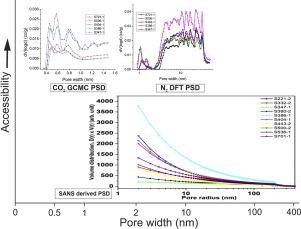当前位置:
X-MOL 学术
›
Int. J. Coal Geol.
›
论文详情
Our official English website, www.x-mol.net, welcomes your feedback! (Note: you will need to create a separate account there.)
A novel approach to identify accessible and inaccessible pores in gas shales using combined low-pressure sorption and SAXS/SANS analysis
International Journal of Coal Geology ( IF 5.6 ) Pub Date : 2020-08-01 , DOI: 10.1016/j.coal.2020.103556 Debanjan Chandra , Vikram Vishal , Jitendra Bahadur , Debasis Sen
International Journal of Coal Geology ( IF 5.6 ) Pub Date : 2020-08-01 , DOI: 10.1016/j.coal.2020.103556 Debanjan Chandra , Vikram Vishal , Jitendra Bahadur , Debasis Sen

|
Abstract Resolving the pore attributes of gas bearing shale formations is key to precise estimation of the gas-storing capacity of a reservoir. Decades of research and development on the characteristics of shale pores have proven that both organic matter and clay minerals are capable of storing hydrocarbons in their pores by virtue of adsorption; however, very few studies have been able to quantitatively characterize the individual adsorption capacity of clay minerals and organic matter. The volume of the gas that is produced depends on the accessibility to the pores. Due to the very low permeability of shale, there is a significant difference between the accessible pore volume and total pore volume. By general convention, we often term the accessible pore volume as the total pore volume, whereas the total pore volume is usually quite higher than the accessible pore volume. This study attempts to address these two research gaps using Permian age Barakar Formation shales that were collected from two separate sites in the eastern part of India, from a depth range of 221 to 701 m. The shales had a moderately high content of clay (ranging between 25% and 70%) and an abundance of Type III kerogen. The mesopore size distributions were calculated from N2 adsorption isotherms using a combination of N2 upon silicate and N2 upon carbon density functional theory (DFT) model. It shows a 66–100% increase in the cumulative mesopore volume when compared to the conventional N2 upon carbon model. Micropore size distribution was calculated from CO2 adsorption isotherms using CO2 upon the carbon grand canonical Monte Carlo model, which shows a better fitting than the conventional DFT model. Further, a comparison between small-angle X-ray scattering and low-pressure N2 adsorption indicates a 3% to 15% higher fractal dimension of total pores than accessible pores. The ‘degree of connectivity’ of the shale pores was calculated based on the accessible and total pore volumes, which was found to decreasesteadily with depth. Finally, a correlation between the binding potential of the inorganic-organic constituents, and the surface fractal dimension was established using Monte Carlo simulation. We confirmed that the fractal dimension depends on the binding potential of the inorganic-organic matter, and the difference in the fractal dimension of accessible and inaccessible pores could be explained by the smoothening of accessible pores due to pore fluid invasion. This new combined and comprehensive approach will lead to a better understanding of CH4 and CO2 dynamics in shale pores.
中文翻译:

一种结合低压吸附和 SAXS/SANS 分析识别气页岩中可接近和不可接近孔隙的新方法
摘要 解析含气页岩地层的孔隙属性是精确估算储层储气能力的关键。数十年的页岩孔隙特征研究和发展证明,有机质和粘土矿物均能通过吸附作用将碳氢化合物储存在其孔隙中;然而,很少有研究能够定量表征粘土矿物和有机物的单独吸附能力。产生的气体体积取决于孔隙的可及性。由于页岩的渗透率非常低,可及孔隙体积与总孔隙体积之间存在显着差异。按照一般惯例,我们通常将可及孔隙体积称为总孔隙体积,而总孔体积通常远高于可接近的孔体积。本研究试图利用从印度东部两个不同地点收集的二叠纪 Barakar 组页岩来解决这两个研究空白,深度范围为 221 至 701 m。页岩的粘土含量适中(在 25% 到 70% 之间)和丰富的 III 型干酪根。使用硅酸盐上的 N2 和碳密度泛函理论 (DFT) 模型上的 N2 的组合,从 N2 吸附等温线计算中孔尺寸分布。与传统的 N2 碳模型相比,它显示累积中孔体积增加了 66-100%。微孔尺寸分布是根据 CO2 吸附等温线在碳正则蒙特卡罗模型上使用 CO2 计算的,这显示出比传统 DFT 模型更好的拟合。此外,小角度 X 射线散射和低压 N2 吸附之间的比较表明,总孔隙的分形维数比可接近的孔隙高 3% 至 15%。页岩孔隙的“连通度”是根据可接近的孔隙体积和总孔隙体积计算的,发现随着深度的增加,孔隙体积逐渐减小。最后,使用蒙特卡罗模拟建立了无机-有机成分的结合势与表面分形维数之间的相关性。我们证实分形维数取决于无机-有机物质的结合势,并且可及和不可及孔隙的分形维数的差异可以通过孔隙流体侵入导致可及孔隙的平滑来解释。
更新日期:2020-08-01
中文翻译:

一种结合低压吸附和 SAXS/SANS 分析识别气页岩中可接近和不可接近孔隙的新方法
摘要 解析含气页岩地层的孔隙属性是精确估算储层储气能力的关键。数十年的页岩孔隙特征研究和发展证明,有机质和粘土矿物均能通过吸附作用将碳氢化合物储存在其孔隙中;然而,很少有研究能够定量表征粘土矿物和有机物的单独吸附能力。产生的气体体积取决于孔隙的可及性。由于页岩的渗透率非常低,可及孔隙体积与总孔隙体积之间存在显着差异。按照一般惯例,我们通常将可及孔隙体积称为总孔隙体积,而总孔体积通常远高于可接近的孔体积。本研究试图利用从印度东部两个不同地点收集的二叠纪 Barakar 组页岩来解决这两个研究空白,深度范围为 221 至 701 m。页岩的粘土含量适中(在 25% 到 70% 之间)和丰富的 III 型干酪根。使用硅酸盐上的 N2 和碳密度泛函理论 (DFT) 模型上的 N2 的组合,从 N2 吸附等温线计算中孔尺寸分布。与传统的 N2 碳模型相比,它显示累积中孔体积增加了 66-100%。微孔尺寸分布是根据 CO2 吸附等温线在碳正则蒙特卡罗模型上使用 CO2 计算的,这显示出比传统 DFT 模型更好的拟合。此外,小角度 X 射线散射和低压 N2 吸附之间的比较表明,总孔隙的分形维数比可接近的孔隙高 3% 至 15%。页岩孔隙的“连通度”是根据可接近的孔隙体积和总孔隙体积计算的,发现随着深度的增加,孔隙体积逐渐减小。最后,使用蒙特卡罗模拟建立了无机-有机成分的结合势与表面分形维数之间的相关性。我们证实分形维数取决于无机-有机物质的结合势,并且可及和不可及孔隙的分形维数的差异可以通过孔隙流体侵入导致可及孔隙的平滑来解释。



























 京公网安备 11010802027423号
京公网安备 11010802027423号